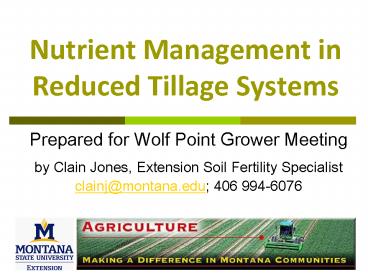Nutrient Management in Reduced Tillage Systems - PowerPoint PPT Presentation
1 / 32
Title:
Nutrient Management in Reduced Tillage Systems
Description:
Discuss how minimum tillage (MT), no-tillage (NT), and conventional tillage (T) can affect: ... Cropping Systems Website: http://scarab.msu.montana.edu/CropSystems ... – PowerPoint PPT presentation
Number of Views:307
Avg rating:3.0/5.0
Title: Nutrient Management in Reduced Tillage Systems
1
Nutrient Management in Reduced Tillage Systems
- Prepared for Wolf Point Grower Meeting
- by Clain Jones, Extension Soil Fertility
Specialist - clainj_at_montana.edu 406 994-6076
2
Objectives
- Discuss extent of different tillage systems in
Montana - Discuss how minimum tillage (MT), no-tillage
(NT), and conventional tillage (T) can affect - Nitrogen (N) mineralization
- Stratification of phosphorus (P) and potassium
(K) - Discuss management recommendations among each
tillage system
3
Minimum Tillage Systems
- 15 to 30 of soil surface contains residue
- Minimal soil disturbance
- Examples
- Stubble mulching Tillage that leaves stubble on
soil surface - Fewer tillage passes
- Shallow tillage
- Strip tillage
4
Conservation Tillage Systems
- High levels of crop residue on soil surface
- Minimal to no soil disturbance from harvest to
harvest - Examples
- Ridge till
- Mulch till Lightly disturbed soil surface prior
to planting - No-till
- Most advanced type of conservation tillage
5
Tillage Systems in Montana
Data from Conservation Technology Information
Center
6
How does stubble height affect fall to spring
soil water?
(Bauer and Tanaka, 1986)
7
DIFFERENCES IN NITROGEN MINERALIZATION
8
How does management affect soil organic carbon?
(Modified from Tilman, 1998)
9
How does tillage affect soil organic matter in
Montana?
(Bricklemyer, 2003)
10
How does tillage level affect soil nitrogen lost
(over 12 years)?
(Lamb et al., 1985)
11
Is growing organic matter free?
- No, it requires nitrogen (N) to grow soil
organic matter (SOM) - To gain 1 SOM in the upper 6 inches of soil, it
takes approximately 1,000 lb N/acre above crop
needs (assuming a 201 SOMN ratio) - Need more N in first few years after converting
to no-till (NT) and less N in long-term to attain
same response as conventional till (T)
12
Nitrogen response in long- and short-term no-till
(Miller et al. 2004)
Why is there a larger difference with protein
than with yield at high N?
13
How do tillage management and nitrogen rate
affect yield?
Mandan, ND
(Halvorson et al. 1999)
14
How do tillage management and nitrogen placement
methods affect yield?
(Mahli and Nyborg, 1992)
15
Nitrogen Management Recommendations
- When banding, place N about 2 inches beside
and/or below the seed row, when possible - Consider
- Injecting N based liquid solutions
- Incorporating granular fertilizer with
irrigation/rain when possible - Applying urea during cool periods
- About 10 lb/ac more N is recommended for the
first 5 to 15 years after conversion to NT and
MT, particularly - In fine- and medium-textured soils
- When N is surface broadcast on stubble
- In long-term, less N will be needed to maximize
yield and protein, especially when more N was
added in short-term
16
Questions so far?
17
DIFFERENCES IN NUTRIENT STRATIFICATIONAND UPTAKE
18
Stratification Cycle
19
Nutrient Stratification
- Stratification, both vertical and horizontal, is
expected to occur more in NT and MT systems due
to less soil mixing by tillage - In fact, in western Canada
- No-till and MT systems resulted in greater
stratification of soil nutrients than T systems
20
Olsen P Distribution at Moccasin
21
Phosphorus Stratification
- Seed-placed P fertilizer applications
- Led to the accumulation of available P in the
surface - Depletion of available P deeper in the soil
profile - BUT, did P uptake by wheat or pea differ between
NT and CT?
22
Winter Wheat Aboveground Phosphorus Uptake
Note Winter wheat fertilized with 20 lb P2O5/ac
23
Winter Pea Aboveground Phosphorus Uptake
Note WP was not fertilized
24
Nitrogen and Potassium Stratification
- In the 0 2 soil layer, soil N and K levels
- Were greater under NT than T
- Gradually decreased to similar levels as T below
2 (Grant and Bailey, 1994 Lupwayi et al., 2006)
- Despite stratification of K, tillage type was not
found to affect K uptake by wheat (Lupwayi et
al., 2006)
25
How do localized concentrations of nutrients
affect root distribution?
(Drew, 1975)
Why does this matter?
26
Management to Counter Stratification
- Sub-surface band P and K with the seed or 2
below the seed to (Grant and Bailey, 1994
Randall and Hoeft, 1988) - Promote deep root growth
- Avoid stranding these nutrients near the soil
surface - Slow the conversion of fertilizer P to less
soluble compounds - Induce a higher yield response as broadcast
applications - Fairly high levels of P can be banded directly
with the seed, but - Apply only 10 30 lb/ac of K2O N (Jacobsen et
al., 2005) - No more than 30 lb/ac of K2O N for barley and
25 lb/ac of K2ON for wheat
27
Questions so far?
28
Summary
29
Summary
- In NT and MT systems, N rates need to be slightly
increased in the short-term to maximize yield and
build SOM to save on N in the long-term - In general, P and K rates do not need to be
adjusted based on tillage system - Sub-surface application of these nutrients is
recommended in NT and MT systems - Starter fertilizer will generally be more
effective in NT and MT systems
30
Summary
- Most problems associated with NT and MT
fertilizer efficiency can be overcome with good
fertilizer management - When feasible, build soil test levels to high
levels before converting to continuous NT or MT - Finally, a top-notch soil testing program is
necessary in any NT or MT system to accurately
determine fertilizer rates
31
Questions?
32
For more Information
- Soil Fertility Website http//landresources.monta
na.edu/soilfertility - Cropping Systems Website
- http//scarab.msu.montana.edu/CropSystems































